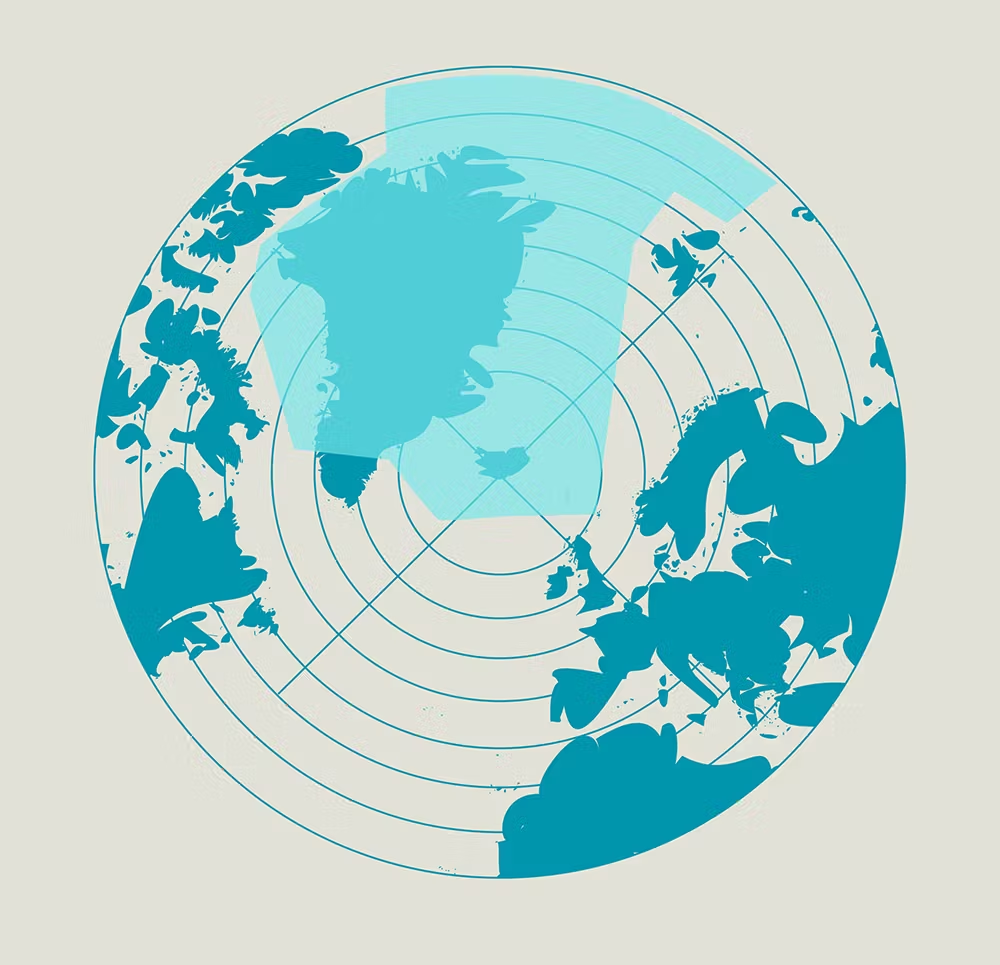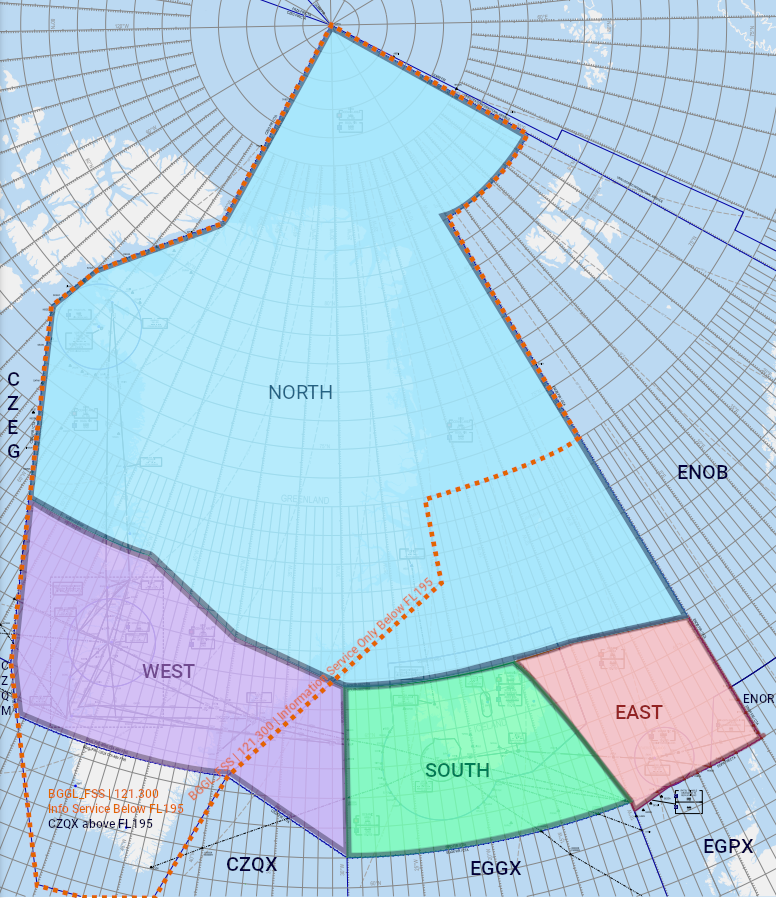General Briefing
Introduction
The Reykjavik Control Area (BIRD CTA) covers over 5.4 million square kilometres of oceanic airspace between North America and Europe, stretching all the way to the North Pole. Under this airspace lie three territories: Iceland, Greenland and the Faroe Islands, each with unique geography, airports, and airspace. Together, they offer the VATSIM pilot limitless opportunities for flying.
Our closest neighbors are Norway, Canada, and Scotland. Neighboring FIRs and oceanic areas include Murmansk (ULMM), Bodo Oceanic (ENOB), Polaris (ENOR/ENSV), Scottish (EGPX/SCO), Shanwick (EGGX), Gander (domestic & oceanic; CZQX/CZQO), and Edmonton (CZEG.)
Sectors
The BIRD CTA is split into four sectors: North, South, East, and West.
The most commonly staffed Reykjavik Control position is BIRD_S1_CTR (frequency 119.700.) This position, when online by itself, covers the West, South, and East sectors, and provides top-down coverage for all of Iceland (BI** airports), EKVG (& surrounding airspace of the Faroe Islands), and BGSF (& surrounding airspace over parts of central Greenland.)
There are, of course, various other BIRD positions available to be opened, where multiple controllers split the various BIRD sectors between them. When multiple BIRD positions are open, you may check vatglasses.uk to see which controller is controlling what airspace, or wait for a “contact me” message from the controller.
NOTE: Sometimes, during major events like Cross the Pond, the division of airspace between controllers may be changed from what it usually is, to accommodate the specific needs of that event. This may cause Vatglasses to be inaccurate. If you receive a “contact me” message from a BIRD controller, even if Vatglasses says you’re not in their airspace, do what the controller says.
The North sector is controlled exclusively by Iceland Radio (BICC_x_FSS.) Iceland Radio is a unique position on VATSIM that provides a variety of air traffic services, including:
- ATC in the North sector.
- Oceanic clearances for airborne aircraft entering the entire BIRD OCA.
- Oceanic/IFR clearances for departures on the ground at Greenlandic uncontrolled airports (usually relayed by local AFIS, but if no local AFIS is online, then pilots may contact BICC directly.)
- (If BGGL_FSS/Nuuk Information is offline and workload permits) Flight information service in Nuuk FIR below FL195, including top-down ATC at BGSF (Kangerlussuaq) if no local BGSF ATC is online.
if you are confused about when to talk to Iceland Radio, simply message the controller (we’re always happy to help, provided we’re not too busy!) or wait for a “contact me” message.
Oceanic Airspace
Much of the BIRD CTA — except some low-level airspace over Iceland and Greenland — is oceanic airspace, forming of the North Altantic (NAT) oceanic area. The parts of the BIRD CTA which are oceanic airspace are known as the Reykjavik Oceanic Area (BIRD OCA.)
Even though the BIRD OCA is oceanic airspace, the entirety of the BIRD CTA/OCA has either radar or ADS-B coverage within controlled airspace. Therefore, position reports are not required, and pilots can expect to receive a typical ATS surveillance service similar to any domestic ATC position, including speed control, vectors, etc.
NAT Tracks
The North Atlantic oceanic airspace uses a system of tracks called the North Atlantic Organized Track System (NAT OTS,) to regulate traffic crossing the ocean. While usually remaining in Shanwick & Gander OCAs, the tracks do occasionally enter the Reykjavik OCA.
If you want to learn more about how the NAT tracks work, read this helpful guide published by the Gander OCA on VATSIM. (Ignore the sections on the routes & Concorde tracks, as they are not relevant to the BIRD OCA.)
Entering Oceanic Airspace
As of 20th March 2024, it is no longer required to obtain an oceanic clearance to fly within the BIRD OCA. However, you must still transmit certain information to Reykjavik prior to entering oceanic airspace, as you would have in the past to request your oceanic clearance.
All flights entering oceanic airspace must have an IFR clearance. It is not permitted to fly VFR in oceanic airspace – you must either fly below controlled airspace (generally, below FL55 over the ocean, or below FL195 over Greenland), or obtain IFR clearance.
If you are:
- Already airborne,
- Entering BIRD OCA, and
- Have not previously spoken to any other oceanic ATC (Gander, Shanwick, etc.)
You need to contact Iceland Radio (if online) or Reykjavik Control before entering oceanic airspace, and provide the controller with the following information:
- Oceanic Entry Point (OEP) – i.e., your first waypoint in oceanic airspace
- ETA for the OEP
- Mach Number
- Requested Flight Level – i.e., intended flight level at oceanic entry
- The highest acceptable (maximum) Flight Level which you can attain at the OEP
Even though there are no more "oceanic clearances," the above procedure is still called a "request for clearance" (RCL) message (yes, it is confusing...)
At the moment, you must use voice to transmit your RCL message to Reykjavik Control/Iceland Radio. The Nattrak website has not been updated yet.
The controller may respond to your RCL message in one of two ways:
- "Fly current flight plan," which means follow your existing flight plan, as previously cleared & loaded into your FMS, with no changes.
- Issuing an amended clearance, which may include changes to your routing, flight level, or Mach speed. This may be necessary to separate you from other traffic, or to fix errors in your original flight plan.
Again, if you have previously received ATC service from any other oceanic sector, e.g., Gander, Shanwick, etc., you do not need to provide Reykjavik Control with a new RCL message.
Voice Phraseology
Example 1: Fly current flight plan (no changes to flight plan required)
🧑✈️ Reykjavik Control, ICE123, request for clearance.
🎧 ICE123, go ahead.
🧑✈️ ICE123, oceanic entry point is VALDI, estimating VALDI at 1234z, Mach .79, FL340, maximum flight level 360.
🎧 ICE123, roger, fly current flight plan.
🧑✈️ Fly current flight plan, ICE123.
Example 2: Amended clearance
If your flight plan must be amended, instead of "fly current flight plan," Reykjavik Control/Iceland Radio will use the phrase "amended [speed/route/level] clearance," followed by the details of the amended clearance. E.g.,
🧑✈️ Reykjavik Control, ICE456, request for clearance.
🎧 ICE456, go ahead.
🧑✈️ ICE456, oceanic entry point is IPTON, estimating IPTON at 1235z, Mach .79, FL340, maximum flight level 360.
🎧 ICE456, amended route and speed clearance, after IPTON cleared direct ING, then direct NASBU, maintain Mach .76.
🧑✈️ After IPTON cleared direct ING then direct NASBU, maintain Mach .76, ICE456.
🎧 ICE456, readback correct.
ATC may also issue a conditional instruction (e.g., cross a waypoint, climb/descend to a level, etc.) "at," "at or before," or "at or after" a certain time, to ensure traffic separation. E.g.,
🎧 ICE456, cross IPTON at or after 1236z.
If you are flying via a NAT track, Reykjavik Control/Iceland Radio will also verify the current TMI number with you prior to oceanic entry, to make sure you are flying the correct tracks. (If you don’t know what a TMI number is, read the Gander OCA guide linked above.)
Within Oceanic Airspace
Cost Index (ECON) Operations
In oceanic airspace, you may now fly in Cost Index (ECON) mode for optimal fuel efficiency – you do not have to strictly adhere to a specific Mach number. You may deviate by up to ±0.02 Mach from the Mach number you originally reported to ATC without prior permission. If they deviate by >0.02 Mach from the originally reported Mach number, you must notify ATC.
Note that controllers may still instruct you to fly a fixed Mach number if required for separation.
This procedure was previously known as "Operation Without Assigned Fixed Speed" (OWAFS) – the difference is that now (as of 20th March 2024), pilots are expected to fly ECON mode by default, not just when ATC instructs "resume normal speed."
Strategic Lateral Offset Procedures (SLOP)
In BIRD OCA, above FL285, you may use SLOP (Strategic Lateral Offset Procedures). This is a random offset off your aircraft's track, intended to "artificially" induce a navigation error that reduces the likelihood two aircraft will occupy the same airspace at once.
At pilot's discretion, aircraft with the capability to offset (using their FMS) may offset right of track, up to a maximum of 2 NM (the exact offset you choose should be random.) ATC does not need to approve SLOP, or be informed when SLOP is in use. Left offsets are prohibited.
You must not apply SLOP below FL285 in the Reykjavik OCA, and must end the use of SLOP before entering domestic airspace.


